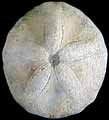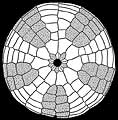Close to Echinarachnius, differing primarily in the position of its periproct. In Astrodapsis the periproct is marginal to submarginal and opens in the fourth or fifth post-basicoronal interambulacral plates, in Echinarachnius it opens between the second and third. In addition the petals of Astrodapsis are typically somewhat raised and the apical disc sunken whereas Echinarachnius has a uniformly convex upper surface.
Faassia Budin, from the late Miocene of Kamchatka, has an inframarginal periproct, as in most species of Astrodapsis. However, oral plating is not reported in the original description and cannot be made out from the illustrated specimen. The position of the periproct, whether opening in the second/third or fourth/fifth post-basicoronal interambulacral plates is crucial for determining whether Faassia is an Astrodapsis or an Echinarachnius. In aboral aspect its petals are flush and so it is tentatively synonymized with Echinarachnius rather than Astrodapsis.
Conrad, T. A. in Antisell, * 1856.Geological report on the Route in California, in Exploration and surveys for a railroad route from the Mississippi U. S. Pacific Railroad Survey, Geology,. Palaeontology Report 7, p. 196, pl. 10, figs 1, 2.
Hall (1962) provides a detailed discussion of this genus.
J. W. Durham 1955 Classification of clypeasteroid echinoids. University of California Publications in Geological Sciences 31, 73-198.
Hall, C. A. 1962. Evolution of the echinoid genus Astrodapsis. University of California Publications in Geological Sciences 40, 47-180, 44 pls.




